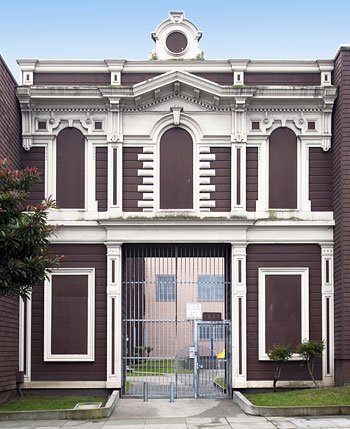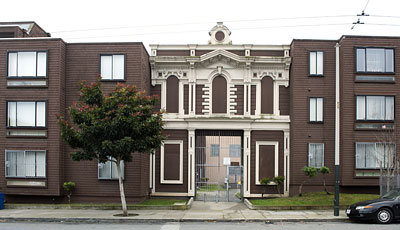San Francisco Points of Interest
1047 McAllister Street
Built 1884
This firehouse was in service from 1884 until 1961.
Shortly after 1961, when the San Francisco Redevelopment Agency bulldozed much of the historic Western Addition, Engine Company No. 14 was demolished except for its façade which was incorporated into an otherwise undistinguished housing complex.

Vintage San Francisco Firehouses
Engine Company No. 1, 451 Pacific Avenue
Engine Company No. 2, 460 Bush Street
Engine Company No. 7, 3160 16th Street
Engine Company No. 8, 1648 Pacific Avenue
Engine Company No. 9 and Fire Boat House, Pier 22½, Embarcadero at Harrison
Engine Company No. 13, 1458 Valencia Street
Engine Company No. 14, 1051 McAllister Street
Engine Company No. 16, 909 Tennessee Street
Engine Company No. 21, 1152 Oak Street
Engine Company No. 22, 1348 10th Avenue
Engine Company No. 23, 3022 Washington Street
Engine Company No. 24, 100 Hoffman Avenue
Engine Company No. 25, 3305 Third Street
Engine Company No. 27, 52 Waller Street
Engine Company No. 30, 1757 Waller Street
Engine Company No. 31, 1088 Green Street
Engine Company No. 33, 117 Broad Street
Engine Company No. 37, 2501 25th Street
Engine Company No. 40, 1249 Clayton Street
Engine Company No. 43, 724 Brazil Avenue
Engine Company No. 44, 3816 22nd Street
Engine Company No. 47, 1298 Girard Street
Engine Company No. 48, 798 Wisconsin Street
Dennis T Sullivan Memorial Fire Chief's Home
Pumping Station No. 2
Underwriter's Fire Patrol, 147 Natoma Street
GuardiansofTheCity.org is the definitive Web guide to San Francisco firehouses, both vintage and modern.

Façadism
Wikipedia defines Façadism (or Façadomy) as the practice of demolishing a building but leaving its façade intact for the purposes of building new structures in it or around it.
The International Charter for the Conservation and Restoration of Monuments and Sites (The Venice Charter of 1964) provided the doctrinal foundation for the modern preservation movement.
Although the United States did not participate in the preparation of the charter, the charter provided the basis for the Secretary of Interior's Standards for Historic Preservation. US/ICOMOS was founded in the 1960s to foster heritage conservation and historic preservation.
Article 1 of the Venice Charter
The concept of a historic monument embraces not only the single architectural work but also the urban or rural setting in which is found the evidence of a particular civilization, a significant development or a historic event. This applies not only to great works of art but also to more modest works of the past which have acquired cultural significance with the passing of time.
Article 7 of the Venice Charter
A monument is inseparable from the history to which it bears witness and from the setting in which it occurs. The moving of all or part of a monument cannot be allowed except where the safeguarding of that monument demands it or where it is justified by national or international interest of paramount importance.
Article 13 of the Venice Charter
Additions cannot be allowed except in so far as they do not detract from the interesting parts of the building, its traditional setting, the balance of its composition and its relation with its surroundings.
Paul Golderberger, writing in the New York Times on 15 July 1985 (Façadism on the Rise: Preservation or Illusion?), gives an argument against urban façadism.
For façadism holds out a great temptation. It seems, on the surface, to give both sides what they want. The small, older buildings valued by preservationists appear to be saved, while the large new ones developers seek can still be built.Façadism in San Francisco:But while façadism pretends to a certain earnestness, it is at bottom rather pernicious. For the compromise it represents is not really preservation at all. To save only the facade of a building is not to save its essence; it is to turn the building into a stage set, into a cute toy intended to make a skyscraper more palatable. And the street becomes a kind of Disneyland of false fronts.
- Belli Building, 722 Montgomery Street
- Borel and Company, 440 Montgomery Street
- Engine Company No. 14 , 1047 McAllister Street
- Genella Building, 726-728 Montgomery Street
- Hoffmann Grill Building, 619 Market Street
- Italian American Bank, 460 Montgomery Street
- South End District
- United States Mint & Subtreasury, 608 Commercial Street
- Minden Butter Manufacturing Company, Minden, NV

